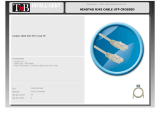
2
ENGLISH
Desktop or shelf installation
When installing the switch on a desktop or shelf, attach these cushion feet on the
bottom at each corner of the device. Allow enough ventilation space between the
device and the objects around it.
Power supply
The switch can be used with 110-240VAC/50-60 Hz input, DC9V/600mA output.
Connecting the switch
PC to switch
A PC can be connected to the switch via a two-pair category 5 UTP/STP straight
cable. The PC (equipped with a RJ-45 10/100Mbps jack) can be connected to
any of the ports. According to the connected network cards, the LEDs indicate at
which speed the card operates. If the LED indicators do not light up after making
a proper connection, check the PC’s LAN card, the cable, switch conditions and
connections. The LED indicator lights up after you’ve made a proper connection.
HUB to switch
A HUB (10/100Base-T) can be connected to the switch via a two-pair category
5 UTP/STP straight cable. Connect a cable to the hub’s uplink (MDI-II) port to any
of the switch’ ports (MDI-X).
Hub without uplink (MDI-II) port
If the hub is not equipped with an uplink (MDI-II) port, you make a connection
using either a straight cable or a crossover cable (see Appendix B,Technical
Specifications for cable requirements).
Using straight cable
When using a straight cable, the connection can be made from the uplink (MDI-II)
port of the switch to any port of the hub.
Using crossover cable
When using a crossover cable, the connection can be made from any port of the
switch to any port of the hub.
Switch to switch (other devices)
The switch can be connected to another switch or device (router, bridge, etc.)via a
two-pair category 5UTP/STP straight or crossover cable.
Using straight cable
When using a straight cable, this is done from the uplink (MDD-II) port of the switch
to any of the 10Mbps or 100Mbps (MDI-X) ports of the other switch or device.
Using crossing cable
When using a crossover cable, this is done from any (MDI-X) port of the switch to
any of the 10Mbps or 100Mbps(MDI-X)port of the other switch or device.
NOTE: The first twisted-pair port (port 1x) is shared with the uplink port. If you
connect a hub to the uplink port, then do not use port 1x.





